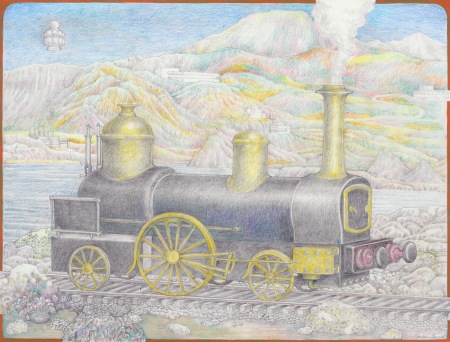Archive for the ‘Railway’ Category
August 22, 2018

The Constitutionalist, 40 x 29,9 cm, pencil, colored pencil on paper
The Constitutionalist, so-called to uphold the value of a carefully set down list of fundamental values and principles according to which a state is to be run or governed, is seen parking in front of a railway station called “Rheinburg”, symbolically so, as the river Rhine is the traditional geographical border between western civilization and the teutonic netherworld, unconstitutional “Hel”. Serving as a permanent control to the permanent control value of the constitution, a floating device in the shape of a futuristic world-lantern, casting its unreal and otherworldly light on the phallic orange body of The Constitutionalist. Ideas of heliocentrism, constitutionalism, anti-dyslexia, state controlled eductation and indoctrination, etc. are all the outgrowth of a patriarchal tradition, the eternal fight against gynaecocracy.
Dyslexia, a silent deviant, an underminer of understanding
Makes values crumble
The book worlds tumble
More proud than humble, as it is powerful
And knows its power well. But not from books.
It’s eminently practical, pragmatic,
But also deceiving.
Know your enemy well, the cunning one
Who does not work with strategy,
Whose moves are based on instincts.
Honing in on the weakness of well-read intellectuals
Spineless thinkers who sold out to the written word
Rendering © 2027 by Torsten Slama, “March Against Dyslexia”, poem by Torsten Slama
Tags:Architecture, Art, Constitutionalism, Drawing, Dyslexia, Gynaecocracy, Modern Architecture, Railway, Steam, Torsten Slama, Transportation
Posted in Drawing, Edwardian, General Art, Locomotive, Model Railroading, Railway, Uncategorized | Leave a Comment »
July 29, 2018

The Plutonian, pencil, coloured pencil, leaf silver, 39 x 29,7 cm
A compact, strong shunting engine well suited to deal with the adversities of everyday life and hard work. The Plutonian world is the opposite of the cool world. You need to be clad in special alloys and have a powerful yet simple method of propulsion in order to survive the first few meters on your way through life. It seems best not to dwell on further associative stream-of-consciousness writing, but to complement this drawing with a poem:
I did it while suffering
I did it while suffering
Medical complications
I did it while
Facing life
From the perspective of death
Surviving death
Every day
Some elementary truths
I picked up
Along the way
Littered on the wayside
Picked truths like flowers
Some hidden truths
Suppressed truths
I did it while suffering
While suffering
I did things
I lifted things
I saw through things
Elementary things
From the perspective of death
I did it.
So you, who see things
From the perspective of life
All pink, rose tinted
Don’t you dare
To criticize
Or nit-pick
What I did
Because I did it
While suffering.
Rendering © 2027 by Torsten Slama and the Shunting Society, “I did it While Suffering”, poem by Torsten Slama
Tags:Art, Drawing, Railway, Shunting, Steam, Switcher, Torsten Slama
Posted in Drawing, Fossil Fuels, General Art, Inner Earth, Locomotive, Plutonian, Railway, Space Art, Uncategorized | Leave a Comment »
April 4, 2018

The Carl Grossberg, 48 x 36,5 cm, mixed media on yellow tone paper
A detailed, if slightly crammed drawing with the theme of what our world would and could have looked like if energy independence, chemical independence, transportation independence and true man-nature metabolism had been the goal of industrialization. The drawing could also be an illustration to a treatise on “The Rift” (in the universal metabolism of nature), as described by Karl Marx. Not that the artist is deeply informed on the subject. In fact, any assumption of true literacy in any genre is categorically refuted (in accordance with the law of humbleness and common sense). Embedded in the rocky landscape background are several stylized coal liquefaction plants or chemical factories, tubes and pipelines, and one motif from a painting by Carl Grossberg (Fabriklandschaft im Schnee, 1923). Of course there is no snow here, as in fact the yellow color of the cardboard on which the scene was drawn evokes impressions of a slightly murky, warm climate (perhaps of the inner earth) with sunlight filtering through a crack in the rocky ceiling, further muted by an emission-saturated atmosphere. The drawing consists of several layers of pencil, colored pencil, washes of acrylics and different reflective and metallic pigments on a base of human spittle (which are in fact all but invisible. Note that the “inner earth / Hollow Earth” theme has all sorts of connotations, historical science fiction ones as well as the psychoanalytical/gynacocratic/chthonic idea of earth as a womb. It seems in any case appropriate to annex a quote by Bernard Herrmann, wherein he describes his ideas about scoring the Filme “Journey to the Center of the Earth” (1959), since that film features landscapes not unlike the one depicted above: “I decided to evoke the mood and feeling of inner Earth by using only instruments played in low registers. Eliminating all strings, I utilized an orchestra of woodwinds and brass, with a large percussion section and many harps. But the truly unique feature of this score is the inclusion of five organs, one large Cathedral and four electronic. These organs were used in many adroit ways to suggest ascent and descent, as well as the mystery of Atlantis.” Drawing and words (except for italicized words by Bernard Herrmann) by Torsten Slama>
Tags:Art, Carl Grossberg, Drawing, Energy Independence, Factory, Illustration, Inner Earth, Metabolism with Nature, Plutonian, Torsten Slama, Transportation
Posted in Drawing, Edwardian, Energy Independence, Fossil Fuels, Illustration, Inner Earth, Locomotive, Plutonian, Railway, Space Planning, Tellurianism, Tone Paper, Uncategorized | Leave a Comment »
March 3, 2018

The Kraftick Liquefaction Plant, 36 x 50 cm, pencil, colored pencil on tone paper
“When Germany still strived for complete autonomy and independence of Western (and Eastern…ed.) influences, coal hydration technology was one of her attempts to realise complete energy independence. Had the hydration plants not been completely eradicated by the end of World War II, their gasoline output would have served Germany’s entire private car fleet well into the 1960’s. ” National Empowerment through Petrolum (NETP)
Apart from all its pertinence to energy empowerment stratagems, this drawing should be judged on its artistic merits and technical peculiarities. Mixed media technique on tone paper makes for interesting depth effects. The pervading pink motor oil atmosphere is sometimes fought back, at times heightened. Some of the liquefaction towers are aslant. The geological rock formation on which the plant rests seems unstable. Even the thick concrete platform on which all rests cannot prevent warping. Yet maybe the warping is only in the eyes and the hands of the draftsperson. Or perceived aslantness could be an optical illusion due to the diagonal dynamics of the rock-layered landscape in the background, which works against the perpendicularness of the liquefaction towers.
In a special effort to facilitate appreciation of technique, two details are included:
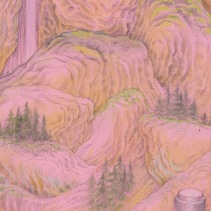
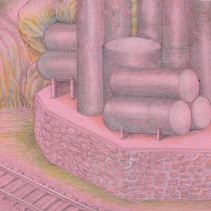
Future © of this motor oil colorized drawing by Torsten Slama,the Energy Independence Society, and the NEPT yet undisclosed
Tags:Architecture, Art, Drawing, Energy Independence, Fossil Fuels, Illustration, Railway, Transportation
Posted in Drawing, Energy Independence, Fossil Fuels, General Art, Illustration, Railway, Tellurianism, Tone Paper | 1 Comment »
December 30, 2017
This reproduction perhaps does not do full justice to the original drawing, which has a rather unusual tonality, based on the blending of so many different brands, types, and colors of the colored pencil variety, all superimposed on an already well-finished pencil drawing with rather profound dynamics in the darkness-lightness range. Thus, the result is very much like a colorized black and white drawing, giving maybe the impression of a very early experiment in colour reproduction. The thematic dedication is referring to a Catholic theologian movement which enjoyed its phase of greatest vivacity from ca. 1660 to 1700 AD. Even though the movement played itself out predominantly in France, it was based on the teachings of a Danish theologian, emphasizing, in typical Nordic fashion, original sin and human depravity. The ?-voiced Commentator “ex”plains: this engine is a very impervious juggernaut, clad in different metallic alloys, being, say, indiscernible to radar, impenetrable by all sorts of electromagnetic radiation, shielded towards the degrading effects of human depravity and all varieties of human frailty. Any kind of believe in a superior being is something like a mental armour, shielding one from the hopelessness of mortality – the machine is a materialization of the urgent desire to overcome death. People often choose suicide to overcome death. They resent their mortal bodies. They would like to have their unique minds stored in metal cylinders — so, in a very roundabout fashion (or in a very allegorical fashion, or maybe in a very freely associative fashion), this drawing could also be called “The Whisperer in Darkness”.
The engine depicted here thus might be the metallic encasing for a human soul, moving through an archetypal, pagan, or, perhaps, Stygian highland (the Gaelic haven to the Teutonic type, disappointed with their own version of a heathenist anti-western world), along some loch, or firth, or estuary, a landscape which might have formed the background to the most impressive feats of early Catholic Christianization, or Westernization.
*On a different and technically more feasible note, the metal cylinder integrated and made ambulatory in the Jansenist engine could also serve as a container for dead bodies (perhaps forever harbouring their souls, even after death), similar to the completely hermetic wood, metal, and wax coffin prescribed for the burial rites in Hans Henny Jahnn’s Church of Ugrino. As Jahnn, author of the deeply hermetic and religious novella “Das Holzschiff”, was himself buried in such a coffin (to prevent his holy body from rotting) it also becomes clear that the Jansenist link was solely associative, because the Jahnnist motif was still hidden in the background. Both spiritual positions describe that which was not embraced by the Catholic Church. Future © of this nostalgia-colorized drawing by Torsten Slama and the Society of Clovis yet undisclosed
Tags:Art, Church, Drawing, Hans Henny Jahnn, Railway Art, Spirituality, Ugrino
Posted in Drawing, General Art, Hans Henny Jahnn, Locomotive, Railway, Ugrino, Uncategorized | Leave a Comment »
December 11, 2017

The Unexamined Brutality (of the male Libido), 70 x 50 cm, Oil on Canvas
This painting seems to hark back to times when the male libido was seemingly more unabashed and comparative innocence (or unabashed guilt) reigned the abusive intercourse between the sexes. The aesthetics are reminiscent of surrealist inspired propaganda imagery. Phallic forms abound. One sea shell stands, or lies, in lieu of the womb. One could argue that the central phallic form of the outer shell of the engine’s boiler is actually esemplastic in not only being the threatening phallus, but also the tubular receptacle hollowness, awaiting the phallic thrust of another longish form entering (see the old chuckle arousing locomotive/tunnel imagery). The ?-voiced Commentator “ex”plains: seeming nostalgia for simpler times does not thinly veil, but starkly outline the fact that we today live in the age where all old violence and abuse bears fruit. The true objectification of the woman takes place in the immediate future which is our presence. Groping will soon be replaced by more sophisticated (and cowardly) methods of abuse. Think about artificial intelligence being furnished with female faces, names, voices. Some are discussing whether these undead freaks should be taught to give more assertive responses to weather queries mixed with risqué innuendo and sexual abuse. Few discuss who decided that “virtual” assistants need female voices and whether it is not a very small step for the brutality of the male libido to then confuse the (universal) assistance offered with the liberties allowed by sex-slavedom.
Observe the more hopeful aspect of the depicted scenery, embodied by a disinterested spectator, a floating space vehicle in the rose tinted sky, watching the travesty on the ground with detached amusement. Maybe the dream of space insemination is not so very unbrutal. The shape and form of the device and its detachment, however, might be. The utopia offered by space.
Future © of this nostalgia-tinted painting by Torsten Slama and the Instrumentality of the Model Railroading Board
Tags:Art, Feminism, General Art, Illustration, Modern, Necrophilia, Oil Painting, Painting, Patriarchy, Railway, Transportation
Posted in General Art, Locomotive, Model Railroading, Oil Painting, Painting, Railway, Space Art, Uncategorized | Leave a Comment »
October 11, 2017
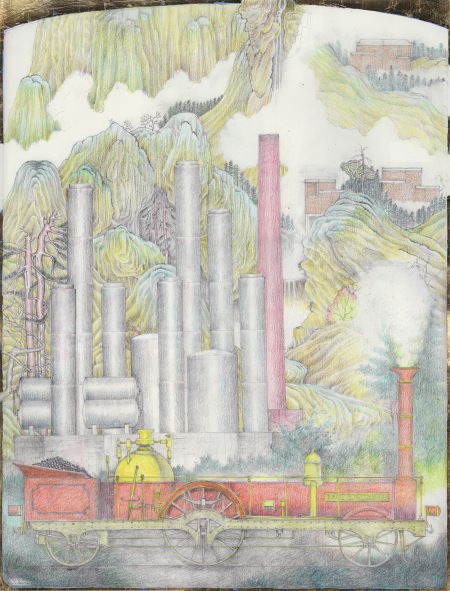
The Dedicated Engine (The Jane G. Goldberg)
Pencil, couloured pencil, gold leaf, 36.5x48cm
Thrusting, trusting, elongated, phallic, dedicated, this engine seems to go somewhere. Yet the composition is static. The engine was copied from one originally painted on glass, perhaps for a magic lantern, which originally bore the name “Little England” on its golden nameplate. The artist decided rather whimsically, truly quite in earnest (though jesting, maybe as a means for self-protection), to change the dedication to “Jane G. Goldberg”, after watching all available sessions of her televised group therapy show on a well known, cheap, as in free (or ad-financed), resource for online videos. Jane G. Goldberg, apart from being a real analyst of the Freudian school, also has a holistic day spa called La Casa Spa and Wellness Center, where amongst other things, one can get one’s colon cleansed, have other things done, and emerge hopefully rather cancer-free, fit for the future allotted to one. Dedications are something questionable, especially unsolicited ones. The author would profess shyness and insecurity about own worthiness as reasons for not seeking such authorisation. The background to the proud engine: a hydrogenation plant for coal liquefaction, either Bergius or Fischer-Tropsch style, ironically rendering coal, which makes the dedicated engine run, into petroleum, to make cars go. Thus the path into the future is opened. A future which now belongs to the past, even though the way to go, electric propulsion, is of course mostly a sham, a magic trick to evade the problem of nuclear fusion or some such groundbreaking thing. The whole further background is a landscape in the Chinese style, with two buildings of unknown purpose, fog, rock, and firs. The entire work forms a kind of stump or rump for a whole holistic world view, such as art should strive for. Stress release (and build up), homogenisation, liquefaction, bowel maintenance, mental control, control functioning, anger management, again liquefaction, energy management, etc. are all the core techniques which ideally should join to form a true society for all, a universe for worthwhile existence, not only in life, but also in death or near-inertness (or extremely slowed down or procrastinated reactiveness), as is the life of a tree, and then, at the furthest end, a rock.
Future © of this atmospheric rendering by Torsten Slama and the Group Therapy Board
Tags:Coal Liquefaction, Drawing, Illustration, Jane G. Goldberg, Little England, Railway, Space Planning, Transportation
Posted in Drawing, General Art, Locomotive, Machine, Railway, Tellurian, Tellurianism | Leave a Comment »
August 11, 2017

The Liverpool (after Cuthbert Hamilton Ellis)
Pencil, Coloured Pencil, 40×29.7cm
This drawing’s slogan: “The good old times weren’t good, just old”. Someone said that and it is not at all clear what they meant. It seems to be something you say when you want to be philosophical, maybe nearing the end of your own time. The steam locomotive stands for old values, which are not good, just old. In truth most friends of steam believe yes, the values are good, not old. The steam engine also is something which enthusiasts describe as an object evoking ecstatic feelings of awe when first beheld. It hisses, has pressure, is a promise of good and functional sexuality. The image of the steam engine says more in the realm of culture, symbolism, and pictorialism then in terms of the actual object depicted. It says something about the owner or the creator of the image. Or rather, it used to say something. Today all is possible, or nothing. Please note the unpainted or stripped totem pole which does look slightly cock-eyed, a phallic symbol introducing the element of anachronism and dislocation. The flying object is perceived by some as a pill of the capsule type, it is rather an oblong paraphrase of something spherical, a type of artistic quote. UFO enthusiasts know the artist referenced. Mostly everybody else also. An anagram: GREATER MIENT. The creator of the totem in the foreground is an anonymous North American Indian. Or rather, this totem is actually a faux totem, as it has different parts from different totems, rearranged, and an atypical base construction. It is possibly hollow and made from acrylics. The creator (engineer) of the Engine is unknown to the author of this drawing, but surely known to the creator of the original painting this drawing pays homage to. That painter is Cuthbert Hamilton Ellis, who usually knew a lot about the engines he painted, as he was seeing his paintings really as substitutes for colour photographs in his learned books specializing on Edwardian railway lore.
Rendering © 2021 by Torsten Slama and the International Steam Traction Board “The good old times were not good, just old”
Tags:Art, Cuthbert Hamilton Ellis, Drawing, Edwardian, Illustration, Railway, Torsten Slama, Transportation
Posted in Drawing, Edwardian, General Art, Locomotive, Machine, Railway | Leave a Comment »
June 6, 2017
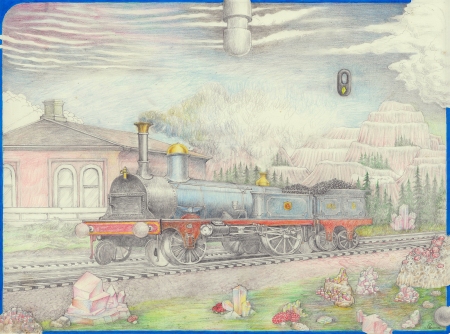
The Confident Engine (after W.W. “Bill” Stewart). pencil, coloured pencil, acrylics, 40×29.7cm
This drawing is based on a painting by the late New Zealand railway painter W.W. Stewart. The New Zealand railway station and the engine was transplanted into a landscape of possibly Triassic character and the people decorating the scenery were eliminated. More specific information about the engine and the railway line could be obtained by a knowledgeable New Zealand railway buff. This artist, in full possession of his artistic prerogative to be weak-suited in terms of research, failed to do so. The copycat artist, having confidence issues, wants to strengthen the impact or poignancy of his drawing by adding the following impromptu piece of poetry (please observe the judicially placed punctuation; a mark of poetry):
Go, Engine of Confidence,
Go your way.
Unencumbered by self-doubt
Say it loud!
You have no capacity for self-doubt.
You are long in the tooth,
wide in the hip
You go on every trip
With confidence.
Engineered to do your best
Not concerned with all the rest
Your path might be crooked
Perspective unsound
Your wheels go round and round
Until you stop.
You are the horse of steel,
A projectile
In fashionable livery
That is your way
Oh could I be
Like you. Atmospheric rendering © 2021 by Torsten Slama and the International Steam Traction Board
Tags:Drawing, Railway Art, Torsten Slama, Transportation, W.W "Bill" Stewart
Posted in Drawing, General Art, Illustration, Machine, Railway | 1 Comment »






